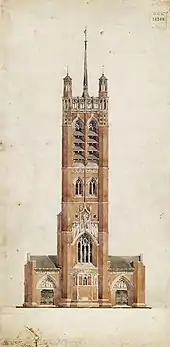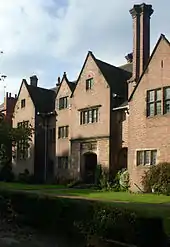William Bidlake
William Henry Bidlake MA, FRIBA (12 May 1861 – 6 April 1938) was a British architect, a leading figure of the Arts and Crafts movement in Birmingham and Director of the School of Architecture at Birmingham School of Art from 1919 until 1924.
William Henry Bidlake MA, FRIBA | |
|---|---|
 Garth House in Edgbaston, Birmingham, designed by the architect | |
| Born | 12 May 1861 Wolverhampton, England |
| Died | 6 April 1938 (aged 76) Wadhurst, Sussex, England |
| Education | Tettenhall College |
| Alma mater | |
| Occupations |
|
| Style | Arts and Crafts |
| Awards | RIBA Pugin Travelling Fellowship |

Several of Bidlake's houses in the Birmingham area were featured in Hermann Muthesius's book Das englische Haus (The English House), which was to prove influential on the early Modern Movement in Germany.
Life and career
Bidlake was born in Wolverhampton, the son of local architect George Bidlake (1830–1892) from whom he received his earliest architectural training. He attended Tettenhall College and Christ's College, Cambridge.[1] In 1882 he moved to London where he studied at the Royal Academy Schools and worked for Gothic Revival architects Bodley and Garner. In 1885 he won the RIBA Pugin Travelling Fellowship for his draughtsmanship, which enabled him to spend 1886 travelling in Italy.
On returning to England in 1887 Bidlake settled in Birmingham where he set up in independent practice and, from 1893, pioneered the teaching of architecture at the Birmingham School of Art. Famously ambidextrous, his party trick was to sketch with both hands simultaneously.
Bidlake designed many Arts and Crafts-influenced houses in upmarket Birmingham districts such as Edgbaston, Moseley, and Four Oaks (the latter then in Warwickshire and absorbed into Birmingham in 1974), along with a series of more Gothic-influenced churches such as St Agatha's, Sparkbrook – generally considered his masterpiece.
He was an associate, member, treasurer and then, from 1902–38, Professor of Architecture of the Royal Birmingham Society of Artists.[2]
In 1924, Bidlake married a woman over twenty years younger than himself and moved to Wadhurst in East Sussex, where he continued to practise until his death[2]
Bidlake died in 1938 and is buried in an unmarked grave in Handsworth Cemetery, Birmingham. In 1909 he had designed the cemetery's chapel, which became a Grade I listed building in 1982.[3]
Major built works

- St Thomas' Church, Stourbridge. Apse (1890), north chancel screen (nd).[4]
- The Dene, 2 Bracebridge Road, Sutton Coldfield, Birmingham (1895–1896), Grade II listed[5]
- Woodside, 51 Bracebridge Road, Four Oaks, Sutton Coldfield (1898) – built for himself
- 17 Barker Road, Sutton Coldfield, Birmingham (1898), Grade II listed[6]
- St Oswald's Church, Small Heath, Birmingham (1892–9), Grade II* listed[7]
- 18 Dora Road, Small Heath, Birmingham (1899), Grade II listed[8]
- College of Art, Balsall Heath, Birmingham (1899), Grade II* listed[9]
- St Patrick's Church, Salter Street, Hockley Heath, Birmingham (chancel) (1899), Grade II* listed[10]
- Woodgate, 37 Hartopp Road, Four Oaks, Sutton Coldfield (1900) – built for himself, Grade II listed[11]
- Garth House, 47 Edgbaston Park Road, Edgbaston, Birmingham (1901), Grade II* listed[12]
- The Hurst, 6 Amesbury Road, Moseley, Birmingham
- Emmanuel Church, Sparkbrook Birmingham (1901)
- St Agatha's Church, Stratford Road, Sparkbrook, Birmingham (1901), Grade I listed[13]
- 100 Sampson Road, Sparkbrook, Birmingham (St Agatha's Vicarage) (1901), Grade II* listed[14]
- St Winnow, 22 Ladywood Road, Sutton Coldfield, Birmingham (1902), Grade II listed[15]
- Bishop Latimer Memorial Church, Winson Green, Birmingham (1904)
- The Knoll, Glebe Road, Oadby, Leicestershire (1907), Grade II listed[16] and Stables, Grade II listed[17]
- St Andrew's Church, Oxhill Road, Handsworth, Birmingham (1907–9), Grade I listed[18]
- St Matthew's Church, Shuttington, Warwickshire (restoration) (1908–1909), Grade II listed[19]
- St Mary's Church, Wythall, Worcestershire. Roof and stair turret (nd).[20]
- Emmanuel Church, Wylde Green, Sutton Coldfield (1909), Grade II* listed[21]
- Gates and four sets of gate piers to Handsworth Cemetery. (1909), Grade II listed[22]
- Lodge to Handsworth Cemetery (1909), Grade II listed[23]
- Mortuary Chapel, Handsworth Cemetery (1910)
- St Clears, 79 Farquhar Road, Birmingham (1914), Grade II listed[24]
- Sparkhill United Church, Stratford Road (1932–3)[25]
References
- "Bidlake, William Henry (BDLK878WH)". A Cambridge Alumni Database. University of Cambridge.
- "William Henry Bidlake MA, FRIBA". Mapping the Practice and Profession of Sculpture in Britain and Ireland 1851-1951. University of Glasgow. Retrieved 14 September 2013.
- "MORTUARY CHAPEL AT HANDSWORTH CEMETERY", National Historic List of England (NHLE), Historic England, accessed 6 September 2023.
- The Buildings of England: Worcestershire, Nikolaus Pevsner, 1968 p268
- Historic England. "The Dene, 2 Bracebridge Road (1067109)". National Heritage List for England. Retrieved 23 August 2021.
- Historic England. "17 Barker Road, Sutton Coldfield (1075817)". National Heritage List for England. Retrieved 23 August 2021.
- Historic England. "Church of St Oswald (1343113)". National Heritage List for England. Retrieved 23 August 2021.
- Historic England. "18 Dora Road, B10 (1210542)". National Heritage List for England. Retrieved 23 August 2021.
- Historic England. "School of Art (1343102)". National Heritage List for England. Retrieved 23 August 2021.
- Historic England. "Church of St Patrick (1342833)". National Heritage List for England. Retrieved 23 August 2021.
- Historic England. "Woodgate (1075828)". National Heritage List for England. Retrieved 23 August 2021.
- Historic England. "Garth House (1075616)". National Heritage List for England. Retrieved 23 August 2021.
- Historic England. "Church of St Agatha (1210221)". National Heritage List for England. Retrieved 23 August 2021.
- Historic England. "100, Sampson Road, B11 (1076179)". National Heritage List for England. Retrieved 23 August 2021.
- Historic England. "22, Ladywood Road, Sutton Coldfield, Birmingham, B74 2QN (1075796)". National Heritage List for England. Retrieved 23 August 2021.
- Historic England. "The Knoll (1073690)". National Heritage List for England. Retrieved 23 August 2021.
- Historic England. "Stables at the Knoll Stables (1073647)". National Heritage List for England. Retrieved 23 August 2021.
- Historic England. "Parish Church of St Andrew (1076219)". National Heritage List for England. Retrieved 23 August 2021.
- Historic England. "Church of St Matthew (1262206)". National Heritage List for England. Retrieved 23 August 2021.
- The Buildings of England: Worcestershire, Nikolaus Pevsner, 1968 p338
- Historic England. "Emmanuel Church (1075819)". National Heritage List for England. Retrieved 23 August 2021.
- Historic England. "Gates and four sets of gate piers to Handsworth Cemetery Immediately South of East Lodge (1343119)". National Heritage List for England. Retrieved 23 August 2021.
- Historic England. "Lodge to Handsworth Cemetery (1219873)". National Heritage List for England. Retrieved 23 August 2021.
- Historic England. "St Clears (1210750)". National Heritage List for England. Retrieved 23 August 2021.
- Historic England. "Sparkhill United Church Including Church Rooms to Rear (1096067)". National Heritage List for England. Retrieved 23 August 2021.
Sources
- Foster, Andy. Pevsner Architectural Guides: Birmingham. Yale University Press: New Haven & London, 2005 ISBN 0-300-10731-5
- Crawford, Alan (ed.). By Hammer and Hand: The Arts and Crafts Movement in Birmingham. Birmingham Museums and Art Gallery, 1984 ISBN 0-7093-0119-7
- Mitchell, Trevor. Birmingham's Victorian and Edwardian Architects Phillada Ballard. ed. Oblong, 2009 ISBN 978-0-9556576-2-7. http://www.victoriansociety.org.uk/news/new-book-celebrates-birminghams-victorian-and-edwardian-architects/ Archived 26 February 2012 at the Wayback Machine.
- Literature by and about William Bidlake in the German National Library catalogue
